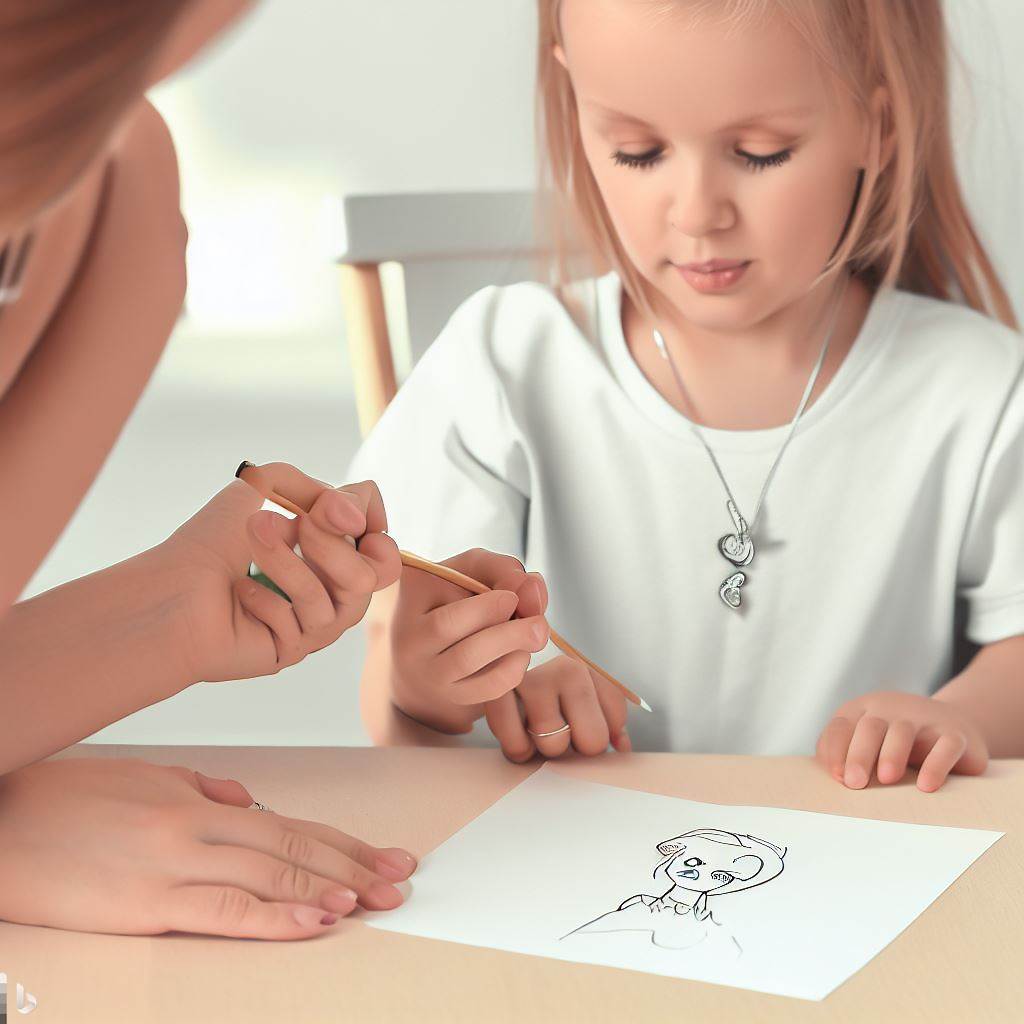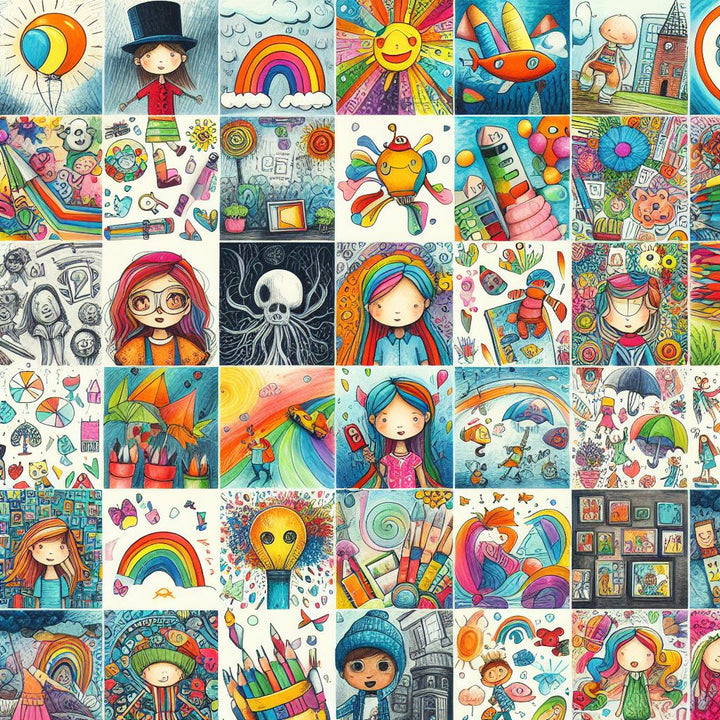In this article, you will find the ultimate guide to displaying children's drawings, updated to 2023.
You will find the answer to the most common and general FAQs about displaying children's drawings.
You will learn of the best places where to display kids' artworks.
You will also get inspired on ways to display kids' art.
If you like this article, you might also like:
And now, let's dive into this blog post's topic!
Displaying Children's Drawing: General FAQ
Below you can find a list of the most common and general FAQs about displaying children's drawings:
What is Drawing?
Drawing is the act of using an instrument to mark a flat surface such as paper. The most common drawing instruments are pencils, pens, and crayons.
What is a Children's Drawing?
A children's drawing is a very simple artwork, made by a child at home or school. It's generally characterized by the absence of realistic details.
Children's Drawing vs Artwork vs Art: What's the Difference?
Drawing is the actual act of using an instrument to mark a flat surface. Artwork is the result of such an act.
In this article, 'Drawing' and 'Art' are interchangeable and are being used as synonyms.
Is Drawing Important for Children?
There are a number of reasons why art is helpful for kids and drawing is important for children:
- It improves arms, shoulders, hands and fingers motor skills
- It allows children to explore creativity without concerning much about the final product
- It helps their cognitive development by establishing neural connections and developing deep thinking
- It helps with their planning skills, especially in relation to deciding on the space each object occupies on the sheet of paper
- It helps children develop eye-hand coordination, which is important in many areas such as sports, handwriting and reading
- It promotes their visual perception
- It greatly increases their attention span by allowing them to focus on an activity for long periods of time
- It's beneficial for expressing their emotions
- It helps their language development
- It boosts their imagination
- By allowing children to manipulate images, drawing helps with developing their problem solving skills
- It helps develop their pre-writing skills
- It helps develop their pre-math skills
- It's a great exercise for their memory
What Are the Main Drawing Stages for Children?
The following are the main drawing stages for children:
- Scribbling (2-4 years)
- Pre-Schematic (4-7 years)
- Schematic (+7 years)
Types of Drawing
There are many types of drawing depending on medium and style. In this article, I am considering drawing with crayons on a sheet of paper as the main type of child art.
What Are the Most Common Subjects of Children's Drawings?
The most common subjects of children's drawings are faces, houses, trees and cars.
Is Displaying Children's Drawings Important?
Displaying your child's artwork is important for a number of reasons:
- It shows parent's support for their activities
- It keeps parents engaged with their children's activities
- It helps children develop a sense of pride for their work
- It encourages their love for art and creativity in general
- It makes a memory of their creations:
Your child will create many amazing things in their lifetime, and these early artworks are things that you’ll likely want to keep (source: artventure.com.au).
Now that it's established what drawing is, why it's important for child development and why it's very important to display their artwork, let's look at where to display your child's art and how.
Places Where to Display Children's Drawing
There are a number of places where to display children's drawings:
- Everywhere
- At Home
- In the Classroom
- Local Libraries
- Local Churches
Displaying Children's Drawings: Everywhere
The absolute best way to display your children's drawing everywhere is by wearing them.
Yes, you've heard it right! You can proudly wear your children's drawings by turning them into a necklace, bracelet or keychain.
This way, you will be able to display your child's art no matter where you are.
This is the preferred way to display children's artwork chosen by thousands of people worldwide.
Displaying Children's Drawings at Home
Displaying children's drawings at home is a popular and recommended choice.
It's also one of the easiest and most practical ways to show your children's your support and engagement everyday.
The two main places where you can display your child's creativity are:
- Walls
- Furniture
Displaying Children's Drawings at Home: Walls
Walls are the most straightforward and traditional place for displaying your children's artworks.
There are a number of ways you can proudly exhibit children's drawings on walls:
- Frames
- Boards
- Posters
- Hangers
- Wires
- Rails
- Ledges or Shelves
Displaying Children's Drawings on Walls: Frames
Frames are an easy and accessible idea for displaying not only photos but also drawings.
The following ideas are meant to inspire you in choosing the right framework for your kids' drawings:
Matching Frame (Gallery)

Photo Credits: Organisedprettyhome.com
A set of matching frames forming a gallery on your living room walls or in their bedroom walls is a great way to proudly display your kids' art.
To add a bit of variety and style, you want to choose frames of the same color but different size and shape.
Peel and Stick Frames (aka Decal Frames)
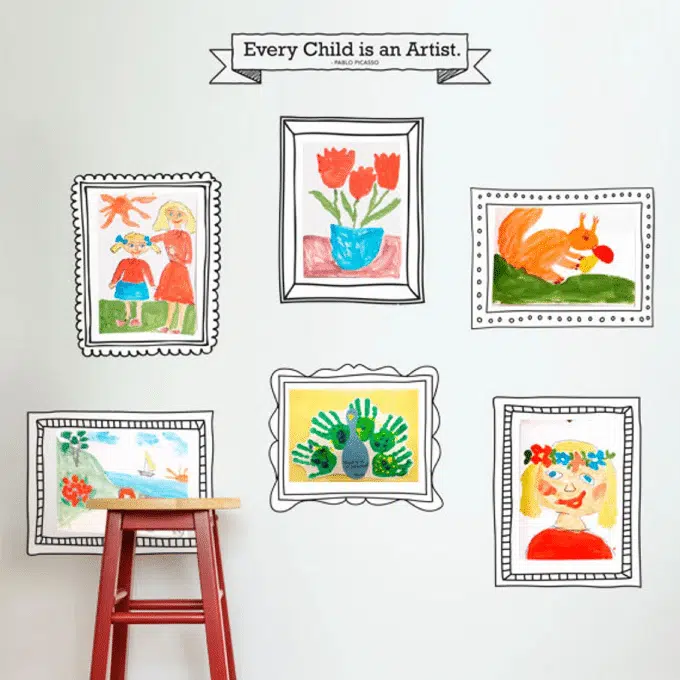
Photo Credits: Artfulparent.com
They are also called frame wall stickers. As the word suggests, they are not actual frames but rather stickers you can stick on the wall without using nails.
Displaying Children's Drawings on Walls: Boards
Boards can be a neat alternative to frames and add your children's drawings that extra layer of professionalism.
In this article, I am considering two types of boards:
Corkboards

Photo Credits: Everymum.ie
If you like frames but are not crazy about the glass, then corkboards are a great alternative for your children's art exhibition at home.
You can buy actual corkboards or simply replace the glass of a traditional frame with cork.
Wooden Clipboard Display
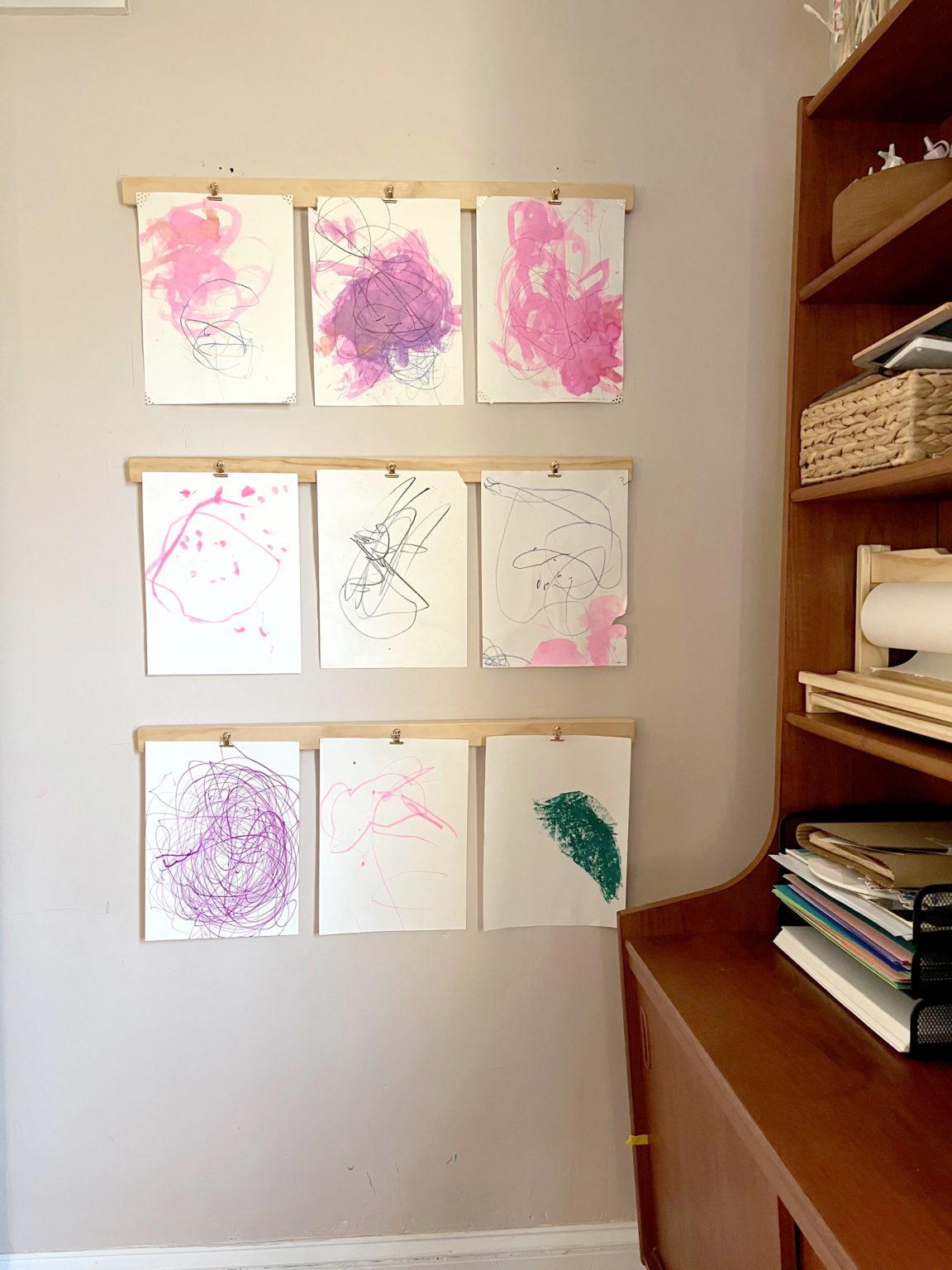
Photo Credits: Rachelwithers.com
Displaying Children's Drawings on Walls: Hangers

Photo Credits: Organisedprettyhome.com
This is a solution that pretty much requires no extra purchase, provided you have a handful of spare hangers.
The recommended ones are skirt or trousers hangers.
Naturally, if you want a more stylish look, you can go on Amazon or Etsy and buy some extra hangers.
One cool idea to display your children's drawings at home is using some magnetic wooden hangers.

Displaying Children's Drawings on Walls: Hanging Wire (+ Pegs)

Photo Credits: Designimprovised.com
This is a more minimalistic solution than frames, boards or hangers and it only requires a bit of wire, which can be made of literally fabric, metal, or plastic.
You will only need some clothes pegs to hang the drawings on.
If you don't like the idea of the wire, why not replacing it with a stylish wooden bead garland?

Photo Credits: Rachelwithers.com
Displaying Children's Drawings on Walls: Curtain Rails

Photo Credits: Everymum.ie
Similar to the hanging wire or garland is the idea of using a curtain rail to hang your children's art on.
In this case you can attach the drawings to curtain hooks with mini clips.
Displaying Children's Drawings on Walls: Posters (Collage)
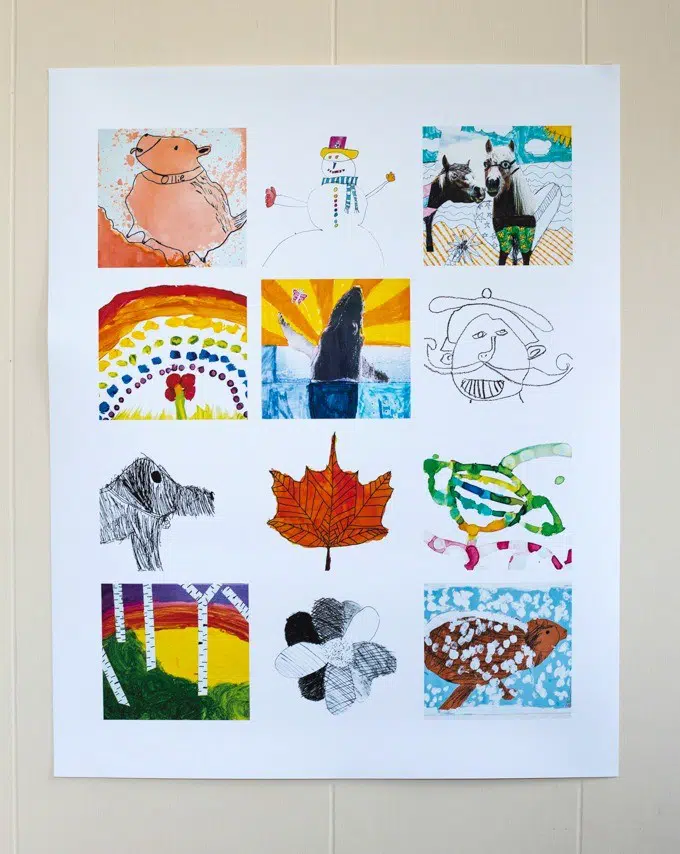
Photo Credits: Artfulparent.com
This is a very simple idea that takes very little to accomplish.
All you need is a big sheet of paper, preferably hard paper, on which you will glue your children's drawings.
The end result will be a beautiful collage.
Displaying Children's Drawings on Walls: Ledges or Shelves

Photo Credits: Organisedprettyhome.com
In between the idea of using the walls to display your kids' art or using your furniture here is ledges or shelves.
You fix the ledges or shelves onto the wall but the actual drawings will have to be placed onto the ledge or shelf.
The recommended solution for this is the traditional frame but you can also place the paper drawings as they are or make a mix of framed and non-framed artworks.
Displaying Children's Drawings at Home: Furniture

Photo Credits: Artfulparent.com
If you don't want to use walls for your art kids gallery at home, you can still display them on any piece of furniture.
In this case, the recommendation is also to use frames.
It could be a pair of frames, of different size and shape, standing next to each other.
Or individual frames placed in different parts of the house.
Displaying Children's Drawings: in the Classroom

Photo Credits: Abrakadoodle.com
Above there are some great ideas if you want to show your support to your children at home.
For teachers, it's also great to display their pupils' drawings in the classroom or school.
Most of the ideas used at home can be recycled for the classroom but some are more specific to the school environment.
I am sure this is currently being done pretty much everywhere but here's a few more ideas to get inspired from:
Displaying Children's Drawings in the Classroom: Frames
I wrote about using actual frames or decals for displaying children's work at home but they can easily be used in the classroom too.
A nice variation could be creating your own frames by using unique textures such as burlap, fabric or grass cloth.
Displaying Children's Drawings in the Classroom: Hangers
Hangers can be a cool idea in the classroom too! Have each student bring a cloth hanger from home or buy them yourself for your class.
An additional activity could be having each child paint their hanger of a color of choice.
Displaying Children's Drawings in the Classroom: Hanging Wires or Garlands
As easy as the idea of using hanging wires or garlands at home, you can maybe use a wire with lights, especially if it's close to Christmas.
Displaying Children's Drawings in the Classroom: Posters
Posters can easily be used in school too. Similarly to what you can do at home, you want to create a collage of drawings.
Considering there are more children's drawings to display in the classroom than at home, you can consider grouping the several artworks under common themes such as subject, medium or type.
Displaying Children's Drawings: Other Places
At home and in the classroom are probably the best and most common locations where your children's drawings can be displayed.
However, they are not the only ones!
Below you can find a list of alternative places where to display your kids' artworks:
- Local Churches
- Local Libraries
- Local Sports Clubs
- Art Galleries
- Work Offices
The list can go on and on and it's really up to you where you think it's best to display your children's art.
Conclusion
In brief, displaying your children's drawings is very important for both your children and yourself.
The most common places where to display the art works are at home and in school.
There are many ways to display their art, on the walls or on a piece of furniture.
However, the absolute best way to display them is to wear them on you as a necklace, bracelet or keychain.
I hope you liked this article. If so, please feel free to share it on your social media profiles, link it from your website and leave some feedback in the comments.



